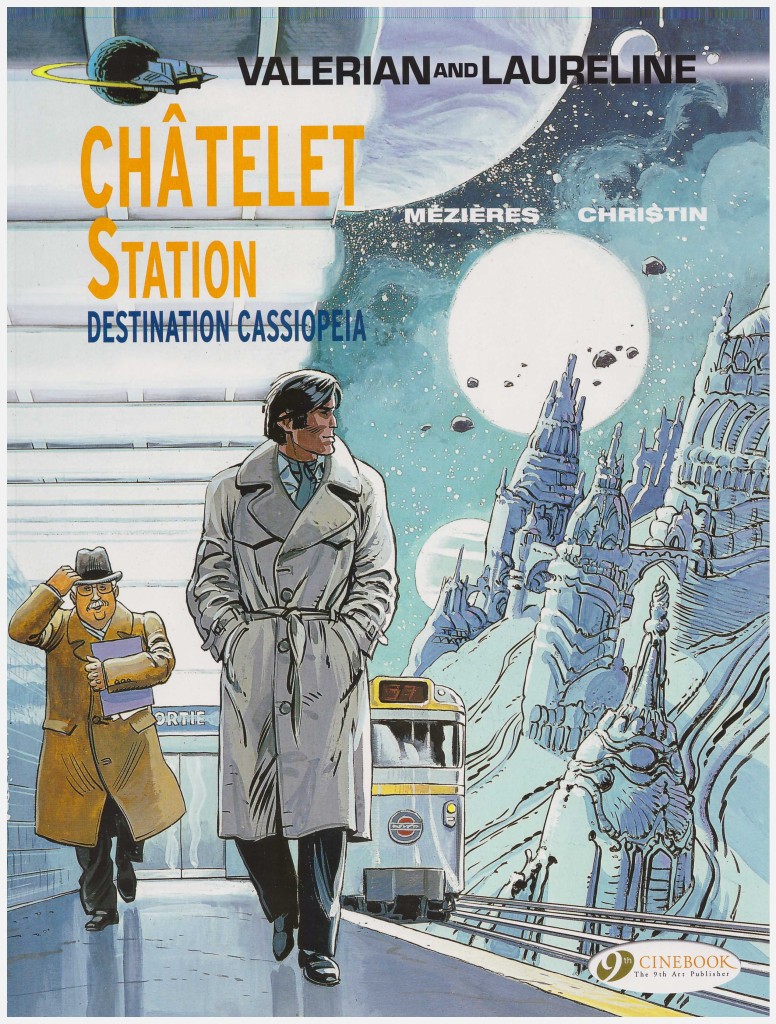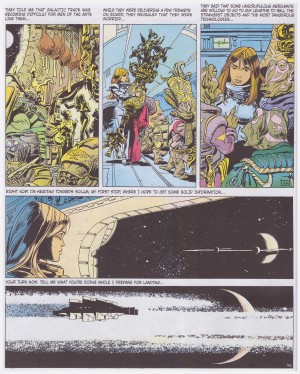Review by Frank Plowright
As indicated by an attention-grabbing cover, Châtelet Station emphasises duality, for starters being the first Valerian and Laureline tale to extend over two graphic novels. Then we have the contrasts of the past and the present (or the present and the future), science and the mystical, the known and the unknown, the sacred and the discarded, and the mundane and the fantastic. There’s even duality in the title, listing locations used in the present and the future. It’s been slow in coming but this is finally a graphic novel that fully represents the high esteem in which Valerian and Laureline is held in France. It’s a wonderful repository of memorable ideas and emotional strength.
Valerian has been sent back to what was present day France when the book was created (1980). In the company of a genial in-place helper named Albert, who’ll be seen again, he travels about Paris and environs attempting to locate a temporal anomaly in which others are also displaying interest. Laureline, meanwhile, is travelling to distant planets on a connected mission to gather information. This contrast is beautifully presented by Jean-Claude Mézières, his depiction of 1980s Paris disciplined and still recognisable, giving way to glorious abstracts of alien surroundings. His emotional subtlety is exemplary, with the distance separating Valerian and Laureline etched on their faces. Over the preceding books Mézières has increasingly provided memorable panels of spacecraft in motion as if viewed by a parallel craft. The last panel of the sample image forms the endpapers for all French hardcover editions of Valerian and Laureline.
Pierre Christin’s plot is languid and intriguing, encompassing enough action to please regular readers, yet investing wholeheartedly in conceptual matters. Christin’s even confident enough to indulge himself by permitting his secondary characters a two page ramble about mysticism and its place in the rational world, highlighting the importance via Valerian’s complete disinterest. Valerian and Laureline have a form of telepathic contact that spans the millennia, and the dreamlike atmosphere of her experiences is well conveyed by contact only occurring when Valerian is on the verge of falling asleep.
Other fine concepts include beings as the verbal repositories for thousands of years of their race’s history gradually sinking further and further below the surface, and a planet used as a galactic garbage dump that’s spawned its own unique religion. The ordinary is also brilliantly represented, with the novelty of his being on the country bus far less appealing to Valerian than it will be to readers used to seeing him in a distant galaxy.
The book concludes in melancholic fashion with a downbeat trench-coated Valerian walking through Paris’ rain washed streets sick of his mission and his separation. The final panels introduce a blonde woman claiming to be a fellow displaced person. He drives off with her and the story continues in Brooklyn Line – Terminus Cosmos.





